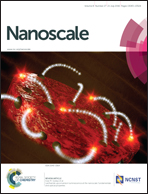3D multiplexed immunoplasmonics microscopy†
Abstract
Selective labelling, identification and spatial distribution of cell surface biomarkers can provide important clinical information, such as distinction between healthy and diseased cells, evolution of a disease and selection of the optimal patient-specific treatment. Immunofluorescence is the gold standard for efficient detection of biomarkers expressed by cells. However, antibodies (Abs) conjugated to fluorescent dyes remain limited by their photobleaching, high sensitivity to the environment, low light intensity, and wide absorption and emission spectra. Immunoplasmonics is a novel microscopy method based on the visualization of Abs-functionalized plasmonic nanoparticles (fNPs) targeting cell surface biomarkers. Tunable fNPs should provide higher multiplexing capacity than immunofluorescence since NPs are photostable over time, strongly scatter light at their plasmon peak wavelengths and can be easily functionalized. In this article, we experimentally demonstrate accurate multiplexed detection based on the immunoplasmonics approach. First, we achieve the selective labelling of three targeted cell surface biomarkers (cluster of differentiation 44 (CD44), epidermal growth factor receptor (EGFR) and voltage-gated K+ channel subunit KV1.1) on human cancer CD44+ EGFR+ KV1.1+ MDA-MB-231 cells and reference CD44− EGFR− KV1.1+ 661W cells. The labelling efficiency with three stable specific immunoplasmonics labels (functionalized silver nanospheres (CD44-AgNSs), gold (Au) NSs (EGFR-AuNSs) and Au nanorods (KV1.1-AuNRs)) detected by reflected light microscopy (RLM) is similar to the one with immunofluorescence. Second, we introduce an improved method for 3D localization and spectral identification of fNPs based on fast z-scanning by RLM with three spectral filters corresponding to the plasmon peak wavelengths of the immunoplasmonics labels in the cellular environment (500 nm for 80 nm AgNSs, 580 nm for 100 nm AuNSs and 700 nm for 40 nm × 92 nm AuNRs). Third, the developed technology is simple and compatible with standard epi-fluorescence microscopes used in biological and clinical laboratories. Thus, 3D multiplexed immunoplasmonics microscopy is ready for clinical applications as a cost-efficient alternative to immunofluorescence.


 Please wait while we load your content...
Please wait while we load your content...